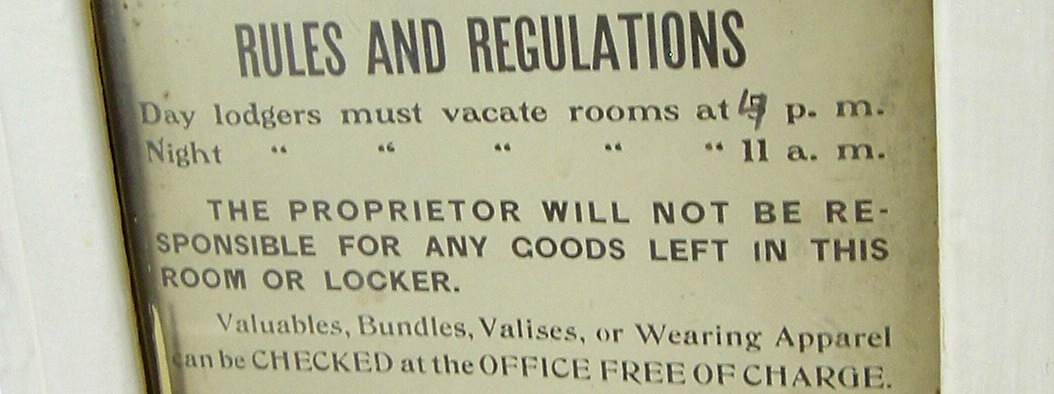
A Tour of the White House SRO On The Bowery
Touring a Single Room Occupancy Hotel
We're looking at some of the SRO or Single Room Occupancy hotels on the Bowery in New York. This was the theatre district in the late 1800s. Then as the city continued to expand toward the north, the Lower East Side became an immigrant district and the Bowery began to deteriorate. Many men were discharged from the military in New York at the end of the First World War, and some of them never left the SROs to return home. Then with the Depression starting with the stock market crash in October, 1929, things got worse. The Bowery was the city's Skid Row until the 1990s. Now the area is gentrifying.
The Bellevue Hotel flophouse (or dormitory) was operating at 340 Bowery in 1899. The Ghelardi family bought the property in 1916, expanding the building and converting it into an SRO with private cubicles. They renamed it the White House. By 1950 there were 234 cubicles.
Around 2000, the number of permanent residents had greatly decreased. The owners modified the building, with permanent residents in the south half, to the left as you face it from the street. The other half was cleaned up, rebuilt, and went into operation as a hostel. Independent travelers could stay there from around 2000 until 2009, when the hostel side was closed for safety reasons by the city with no notice. After further renovation, the hostel side reopened in 2011 and operated until 2014, when it again shut down, this time permanently.
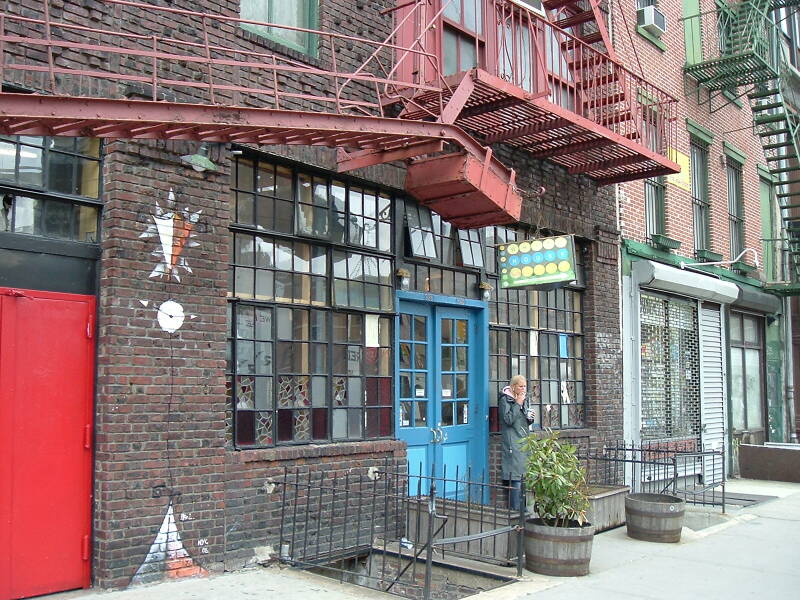
The Entry and the Lobby
Let's go in! The bright blue doors lead into the lobby.
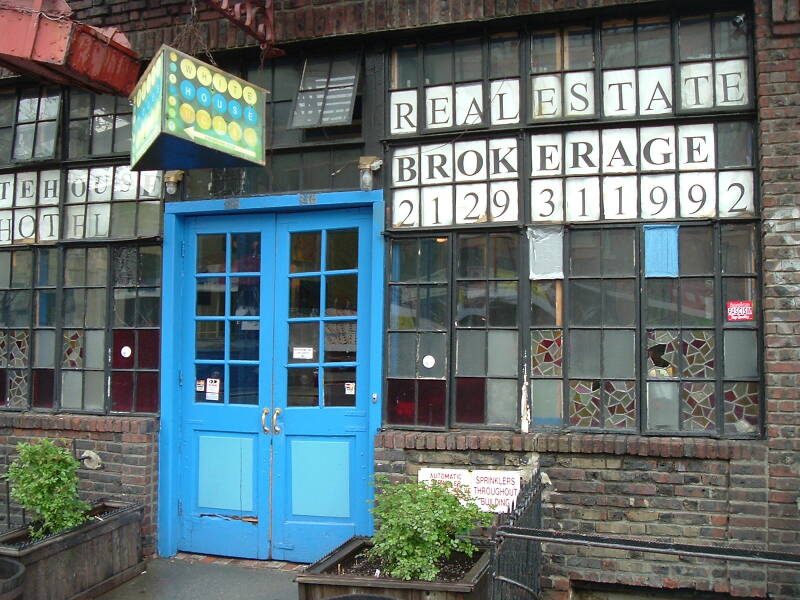
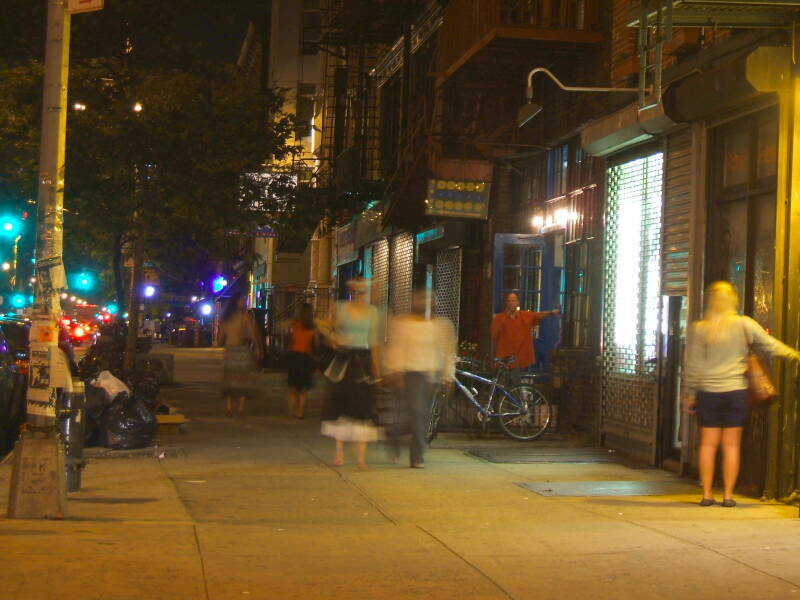
The front desk was staffed 24 hours a day. The keys were attached to large metal rings going through sections of dowel rods about like broom handles. They weren't something you would put in your pocket and forget about. You always gave your name and room number to retrieve your key.
Here are three views looking into the lobby, and three views looking out from near the desk, over a range of years and seasons.
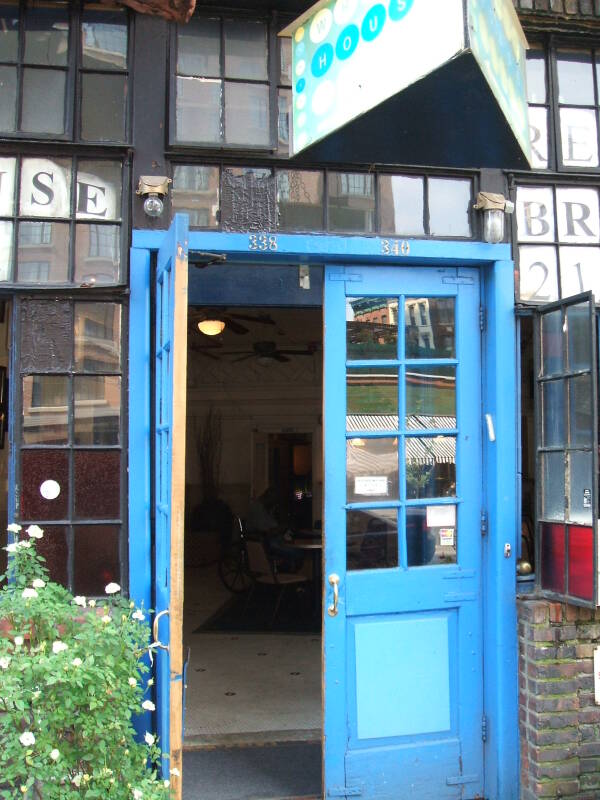
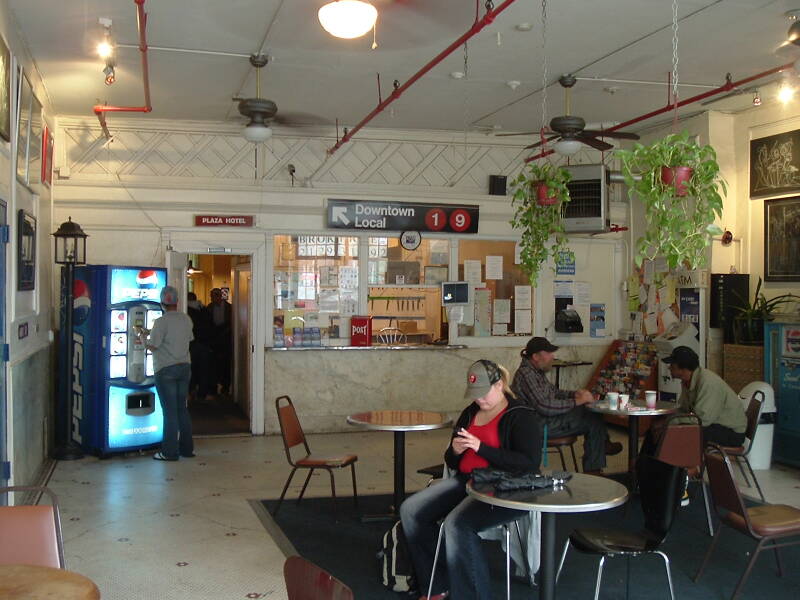
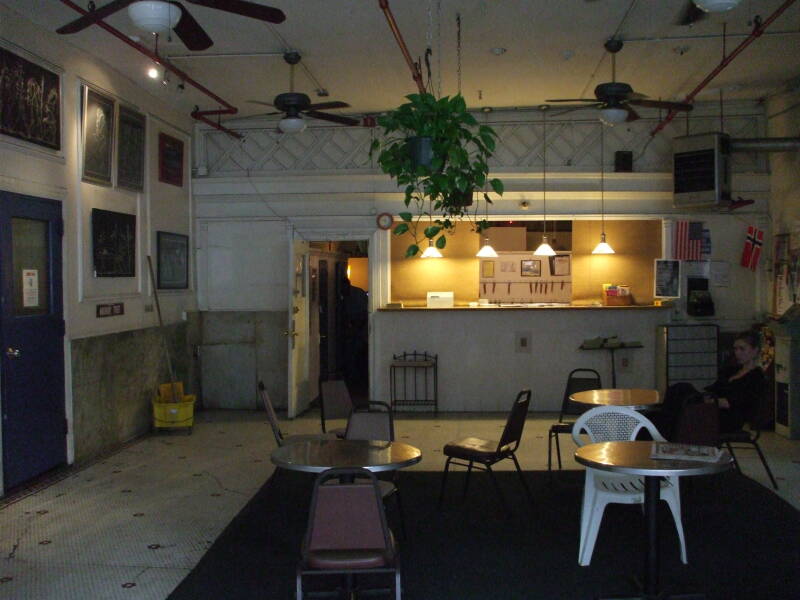
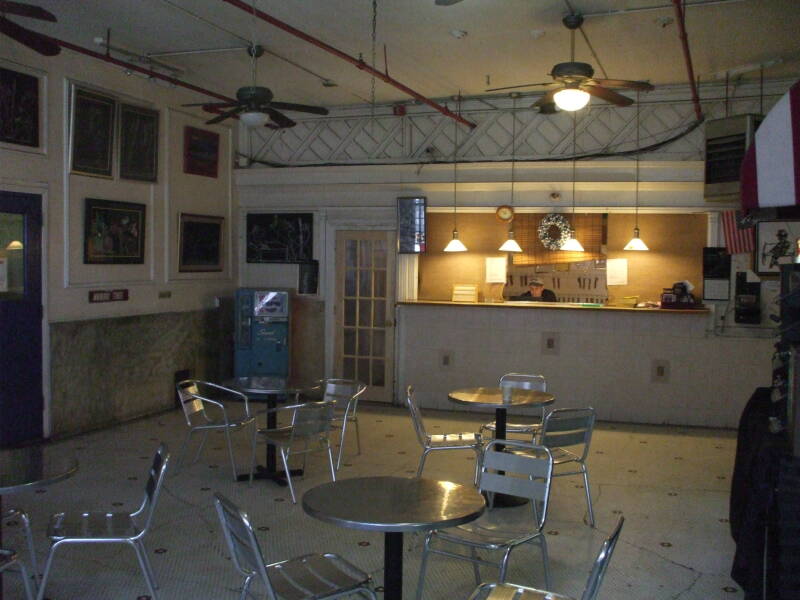
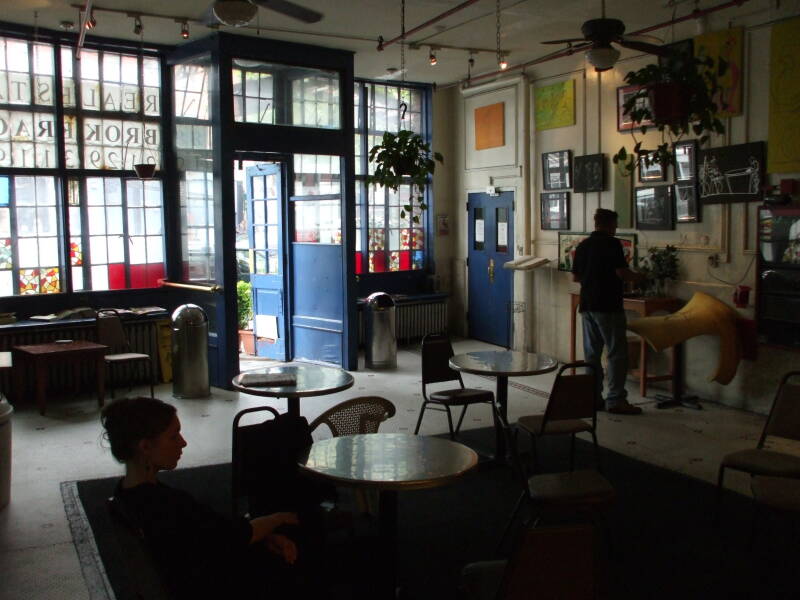
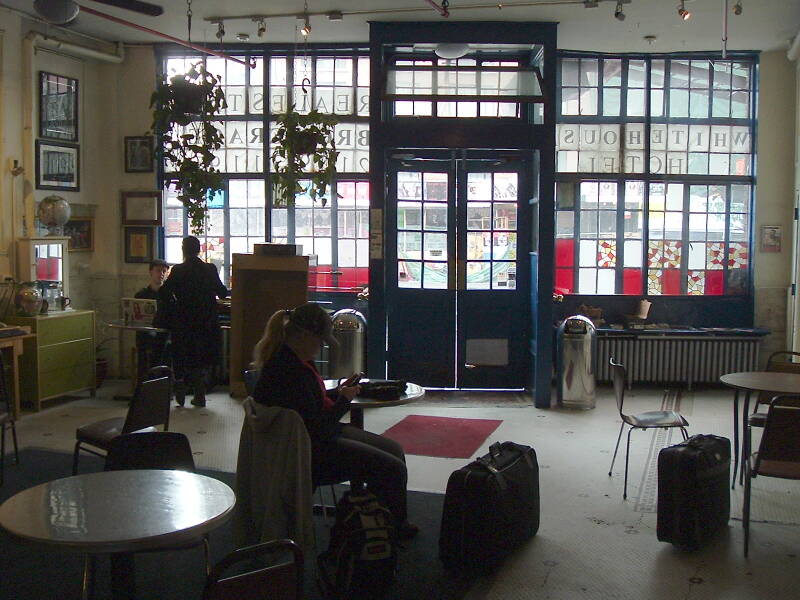
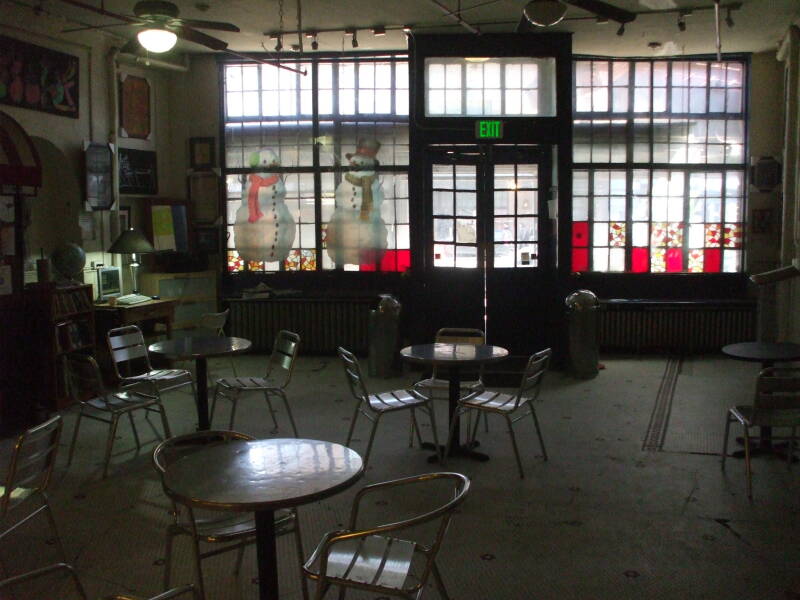
Going Upstairs
Once you had your keys, the door into the stairwell was near the front windows. The person at the desk pressed a button to let you through. Then you climbed one, two, or three floors.
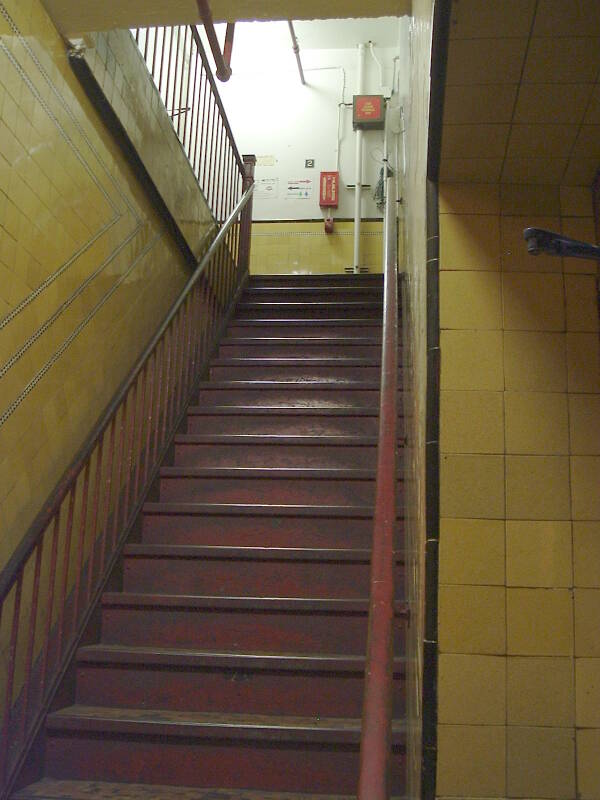
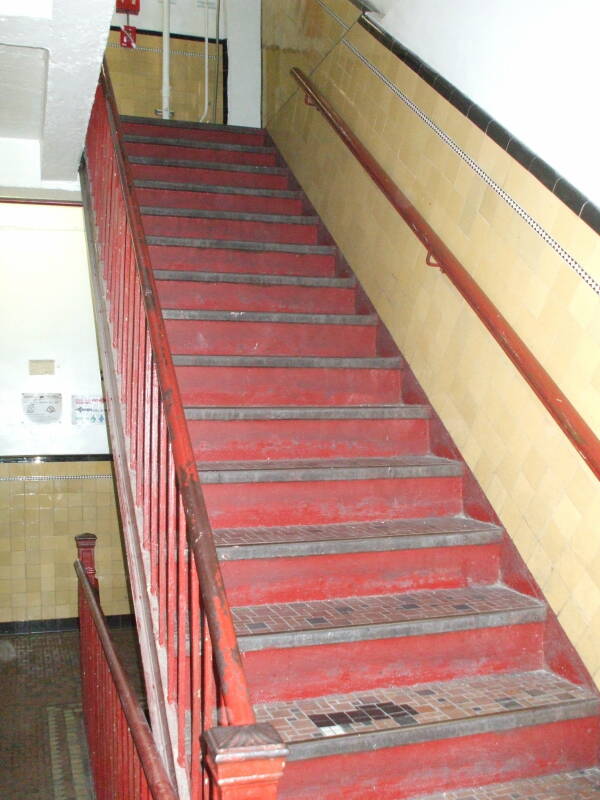
On the second floor, rooms 203—245 were for transient hostel visitors, while 251—279 were for permanent residents.
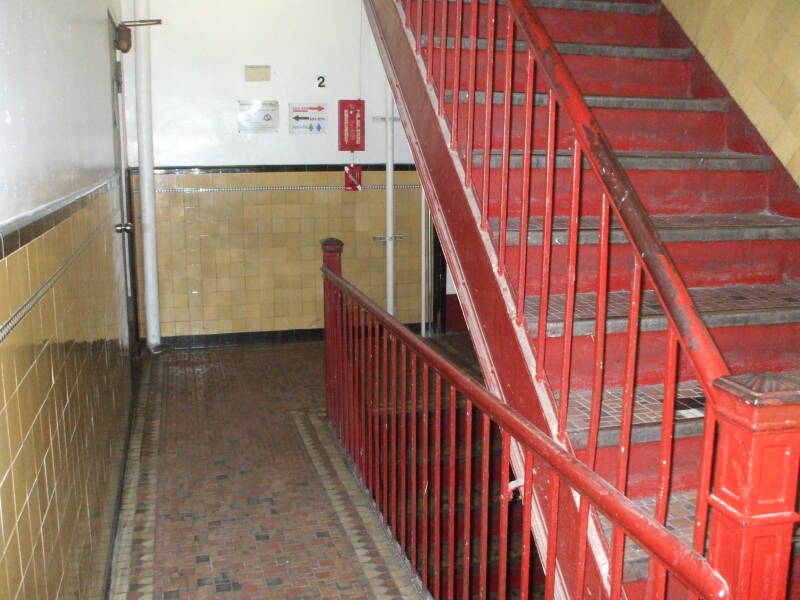
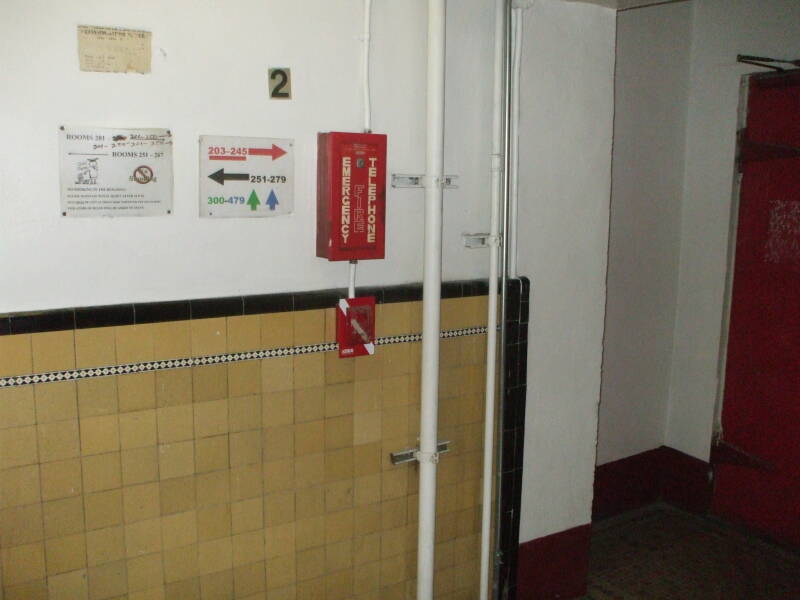
Below we're looking out into the stairwell from the transient hostel visitors side, and then starting back downstairs to explore New York.
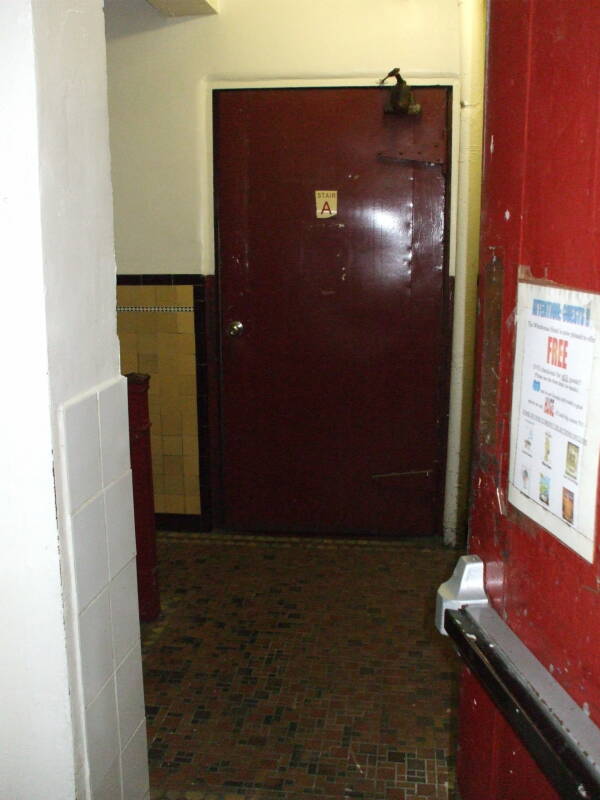
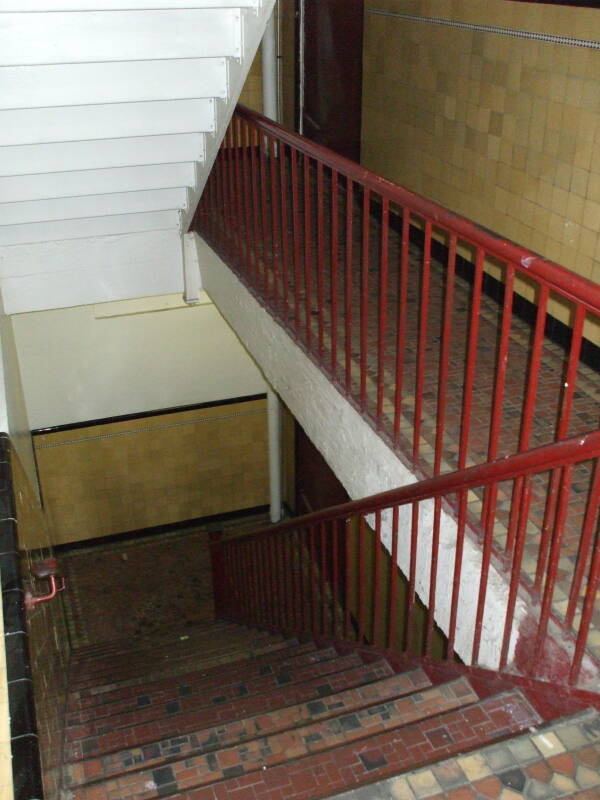
The Halls
Now it's a matter of finding our room, or cubicle. The person at the desk will have told us which floor and to use the first key to go through the door on the right (and it wouldn't open the door on the left anyway). The second key will unlock our room, or cabin.
We will walk up and down the corridors to find our cubicle. We can see the wooden lattice material around and over the tops of the cubicles. Strings of small decorative lights provide adequate illumination at night.
Once you had stayed there, you knew to request a room in a particular area. Some people were bothered by street noise toward the front of the building, but I found it much nicer there than near the showers and toilets at the rear of the building! Without ceilings, the showers became noisy early and stayed that way into mid-morning.
In hot weather, the air conditioners were mostly at the front of the building. Give me a room toward the front and the street any time!
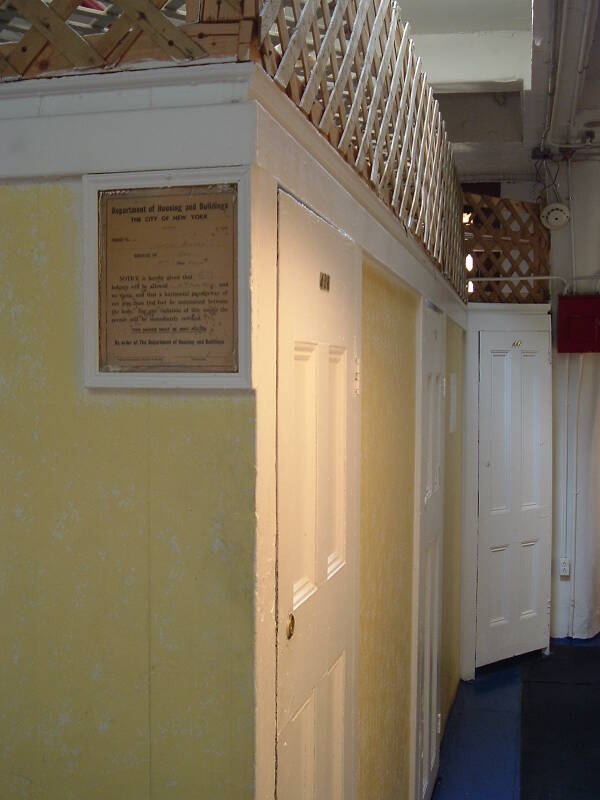
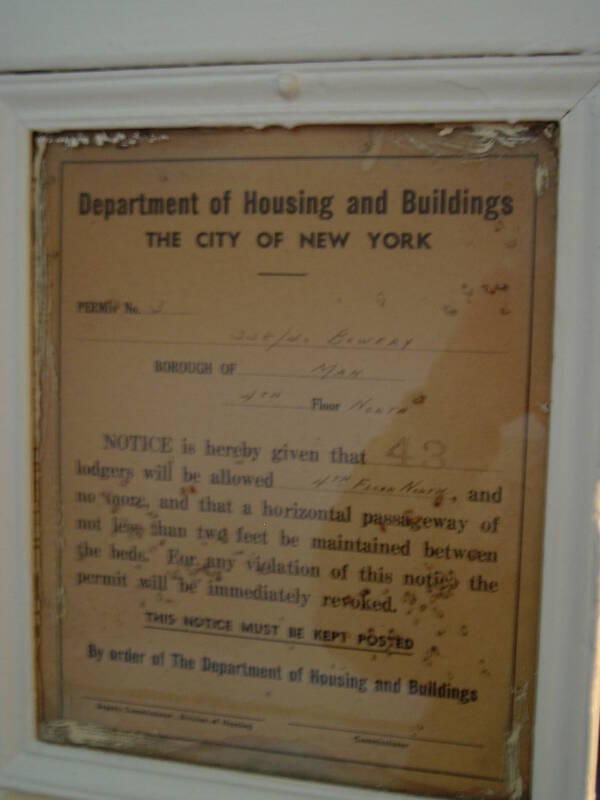
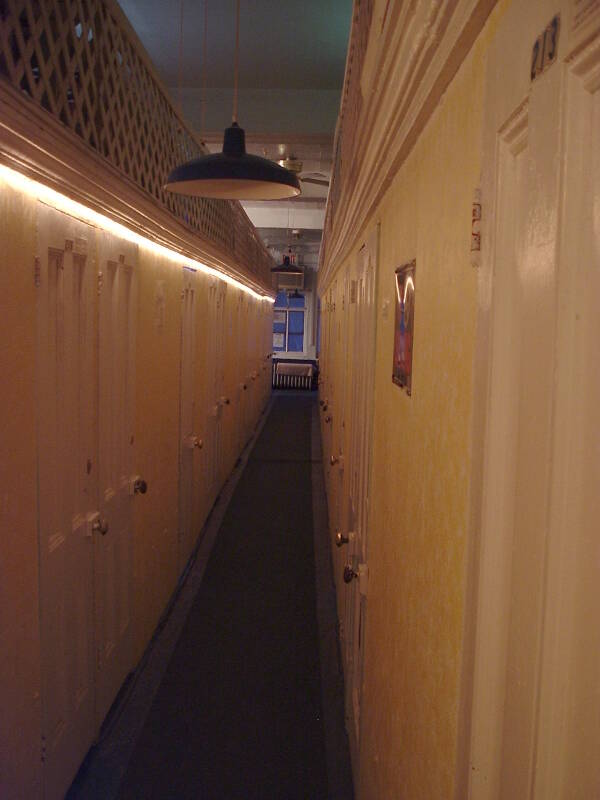
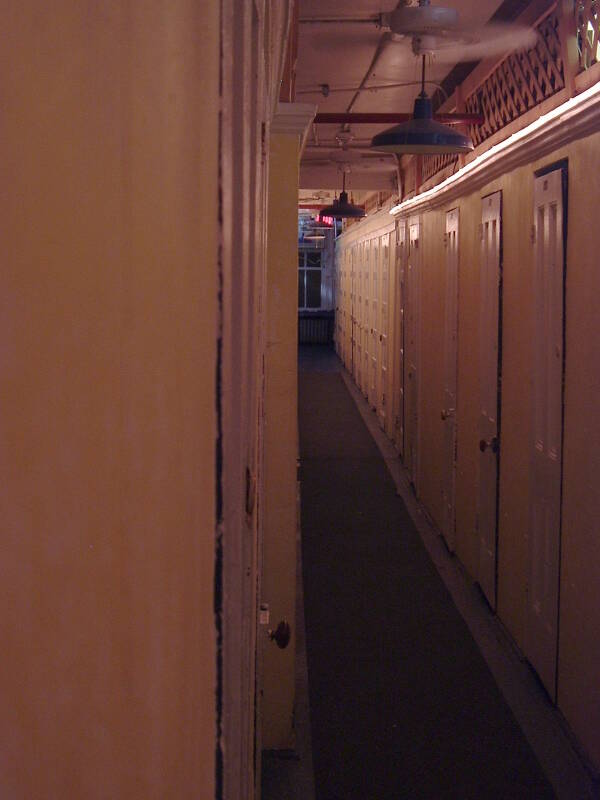
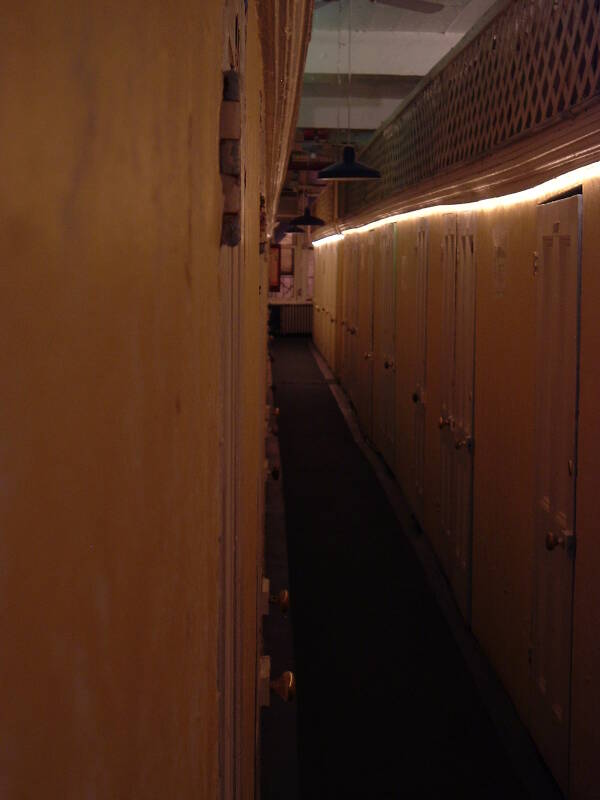
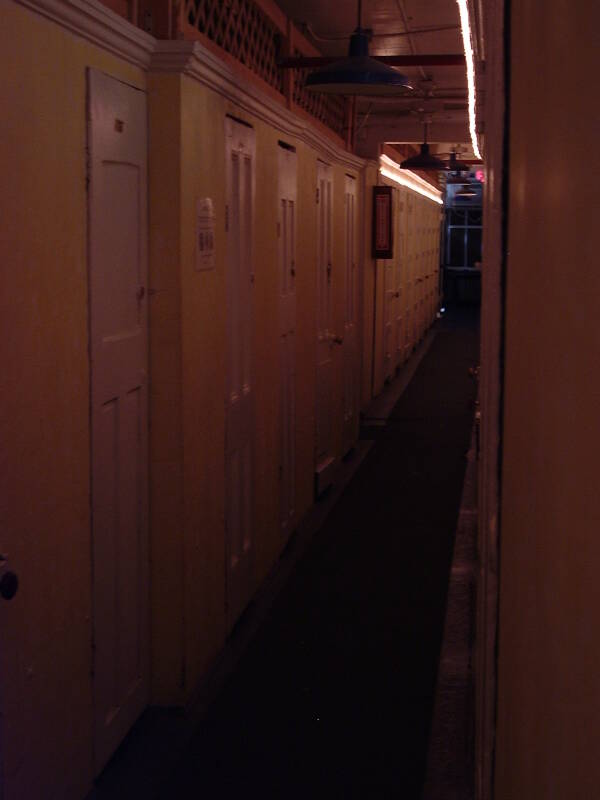
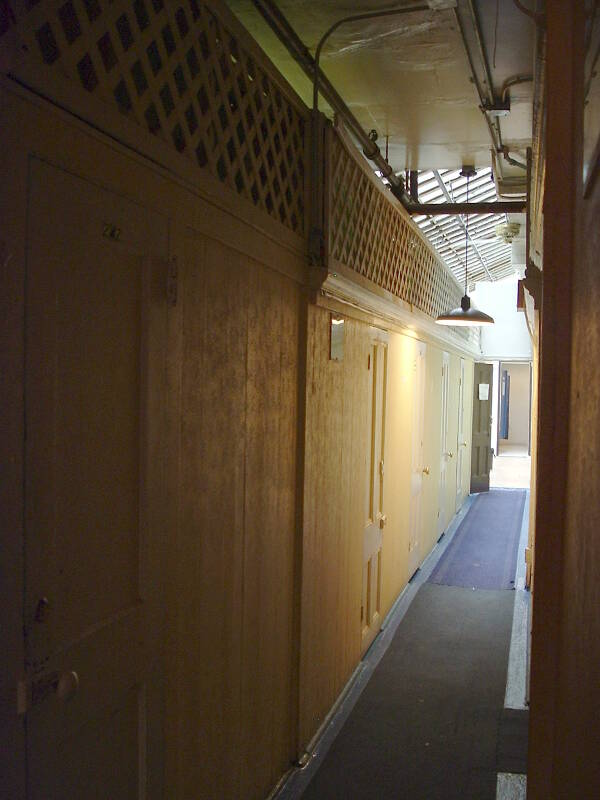
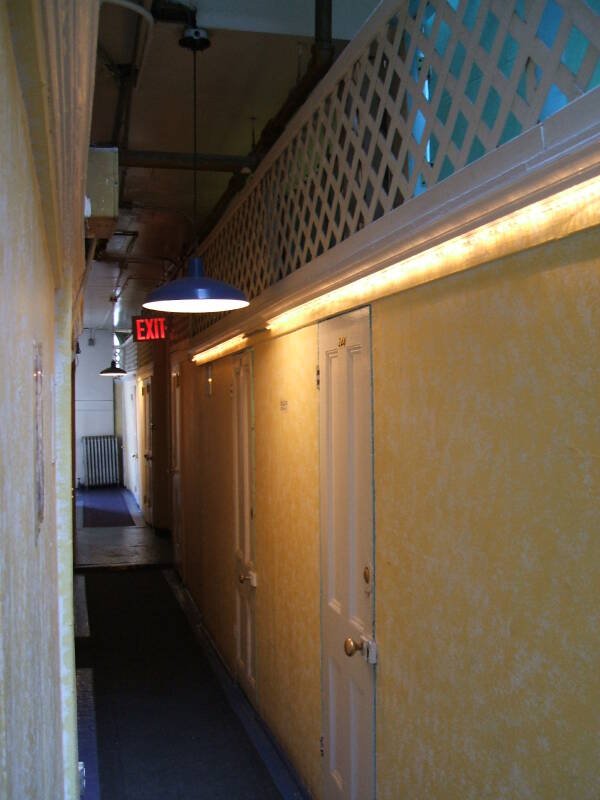
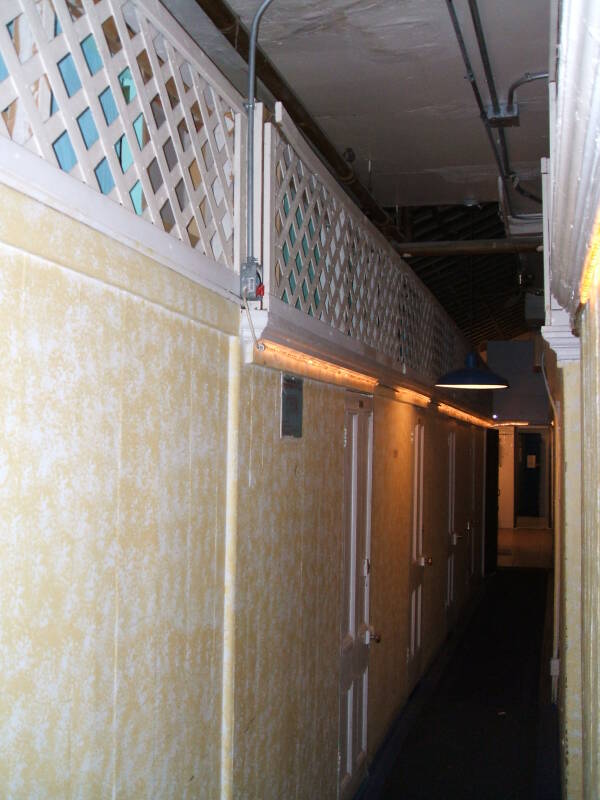
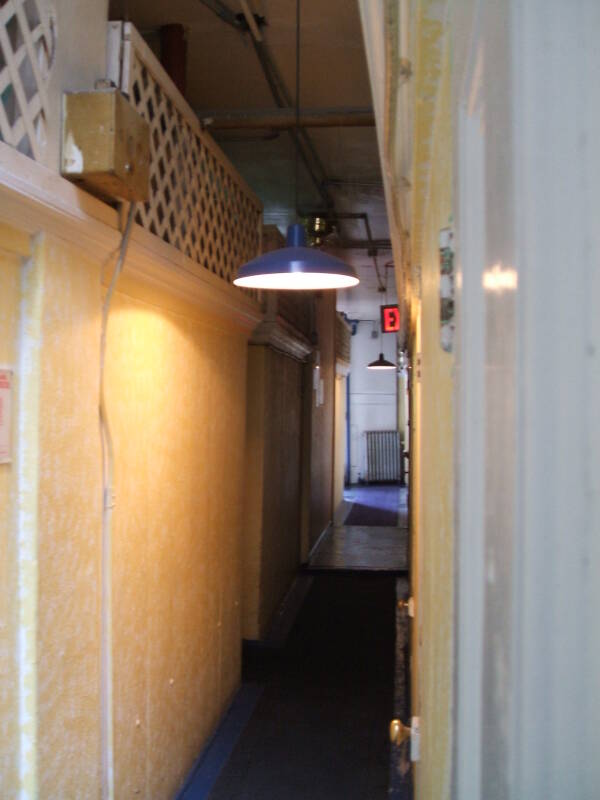
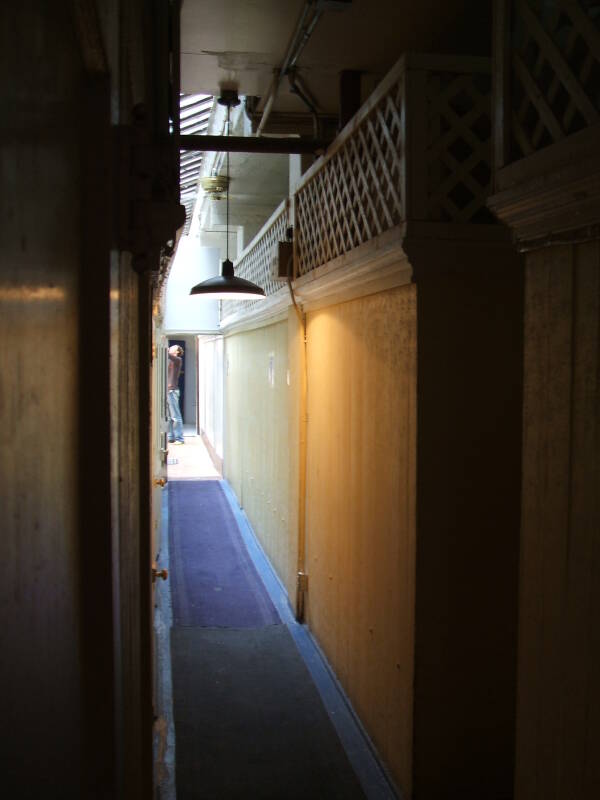
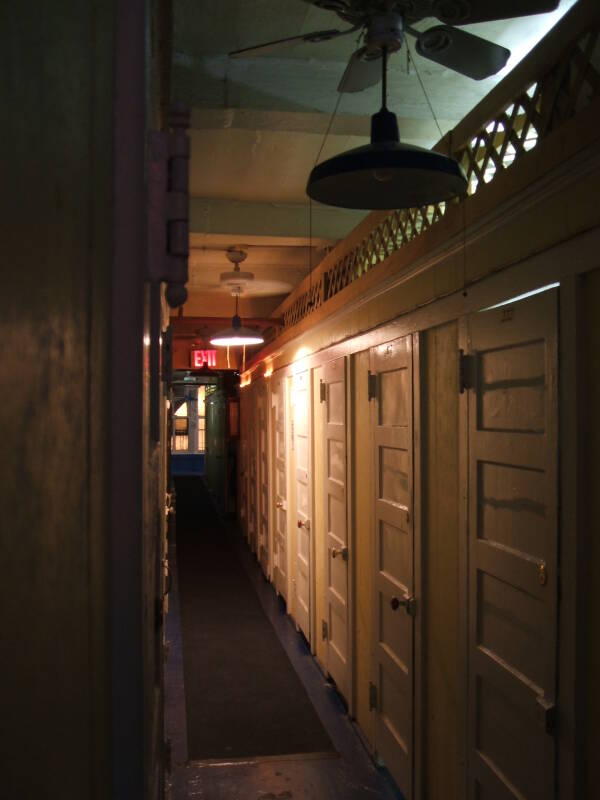
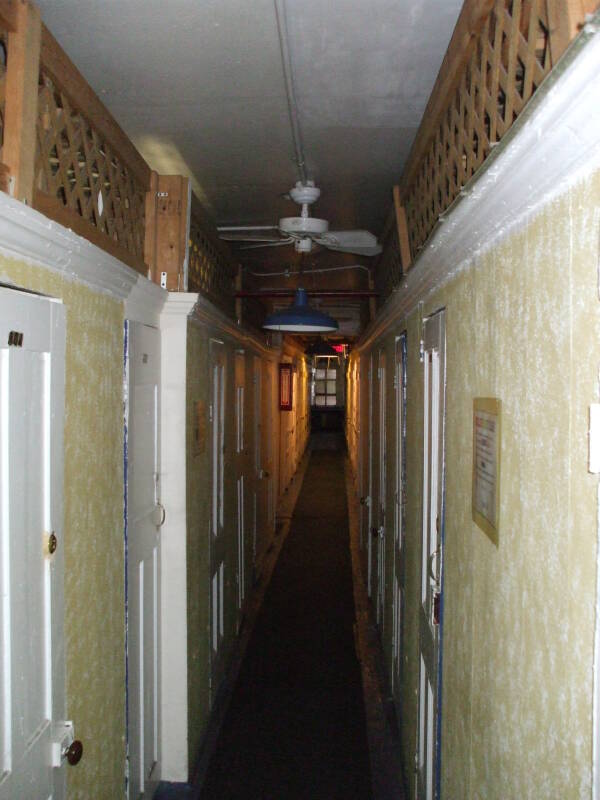
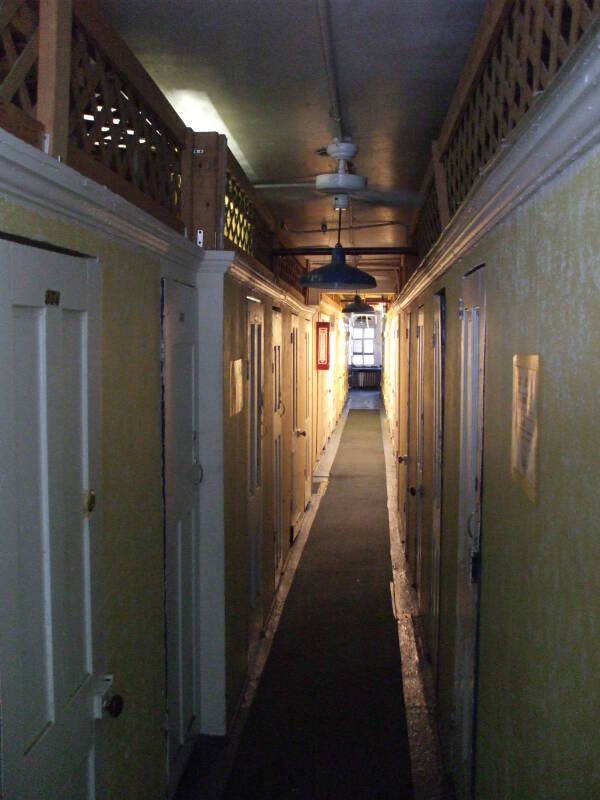
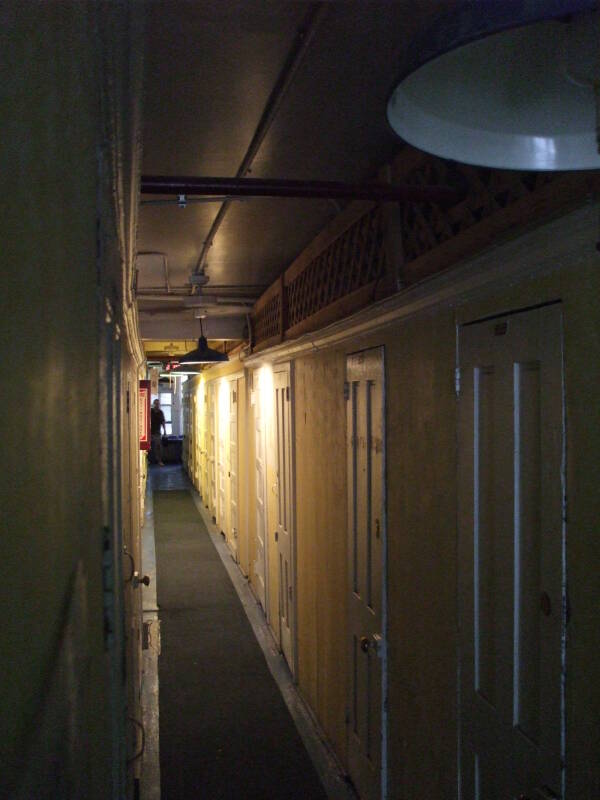
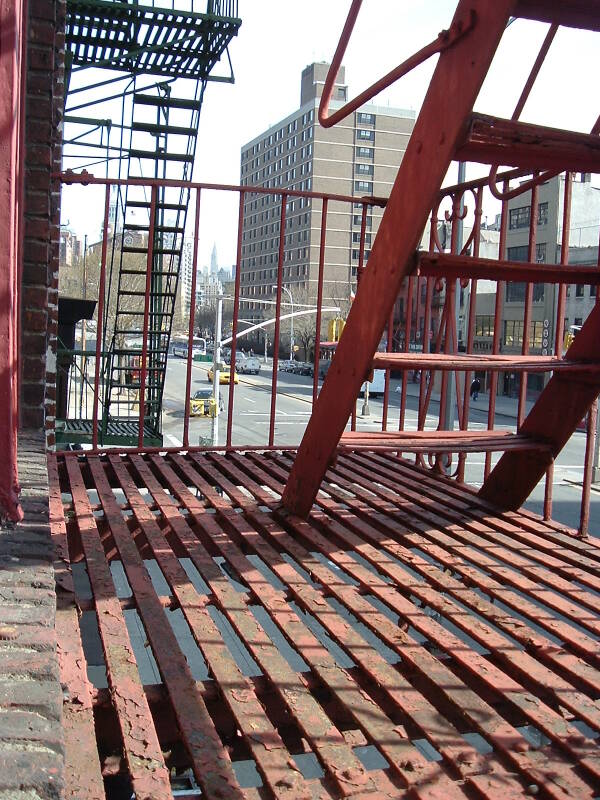
In the last picture above we're looking out the window to the north. The Bowery and Third Avenue join a few blocks north, that's the Chrysler Building visible some 38 blocks to the north.
The Cabins
Let's open the door of my cabin and go in. Most of the space is the bed, a foam mattress on a wooden shelf. That leaves plenty of storage space under the bed.
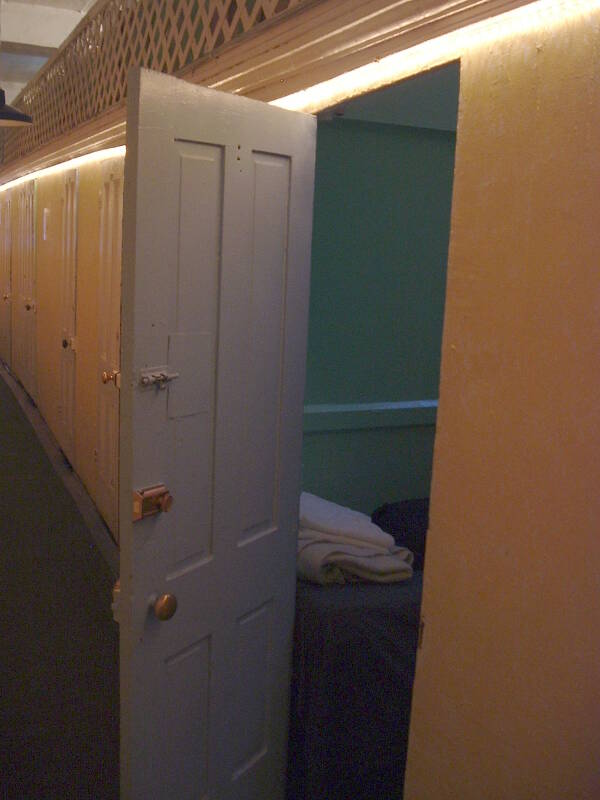
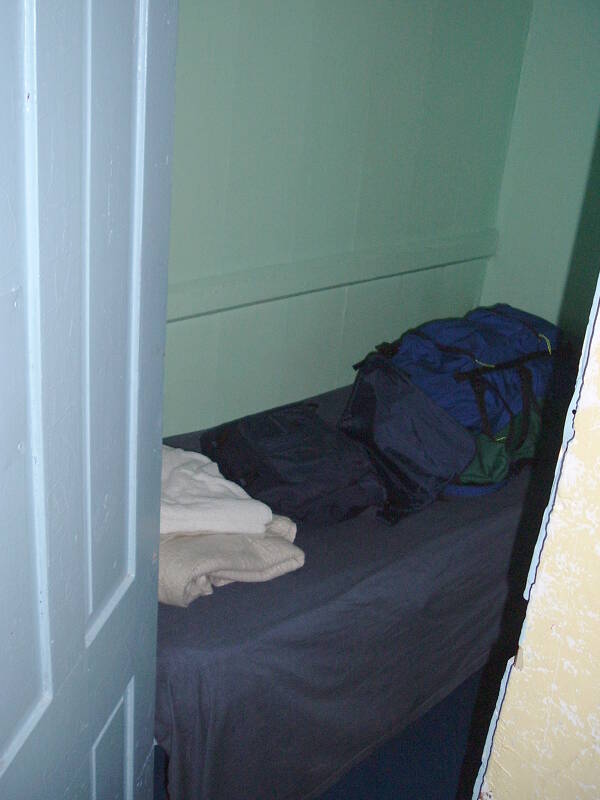
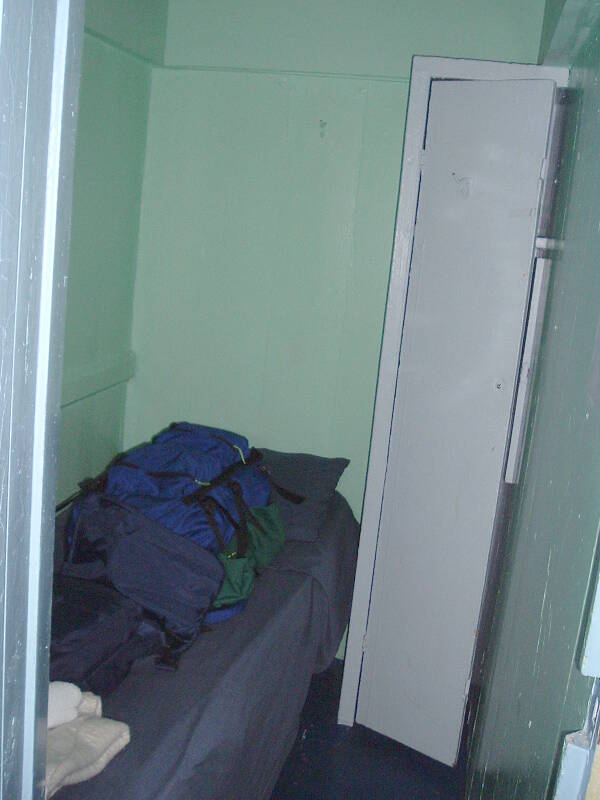
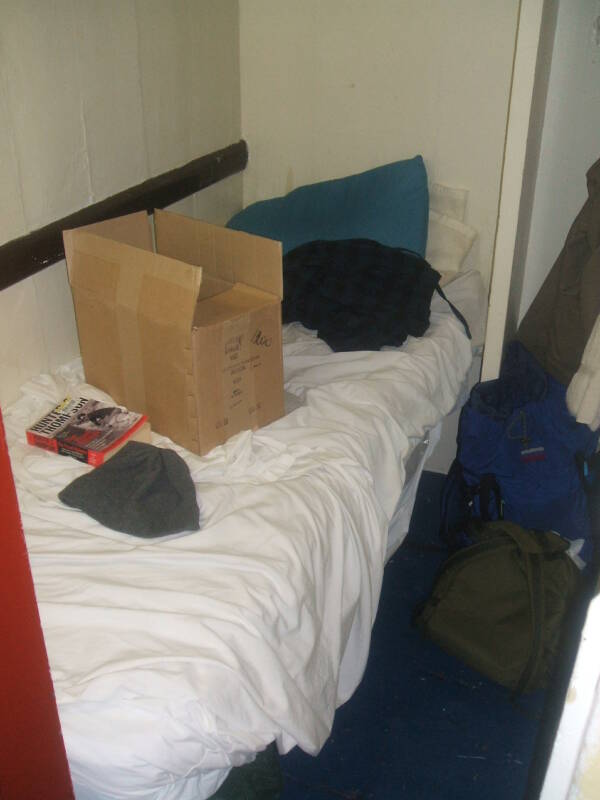
Plenty of space to store purchases at the Strand Bookstore. These pictures are of different cabins I stayed in on multiple visits. I seem to have picked up another collection of Hunter S Thompson's writing every time I went to the Strand...
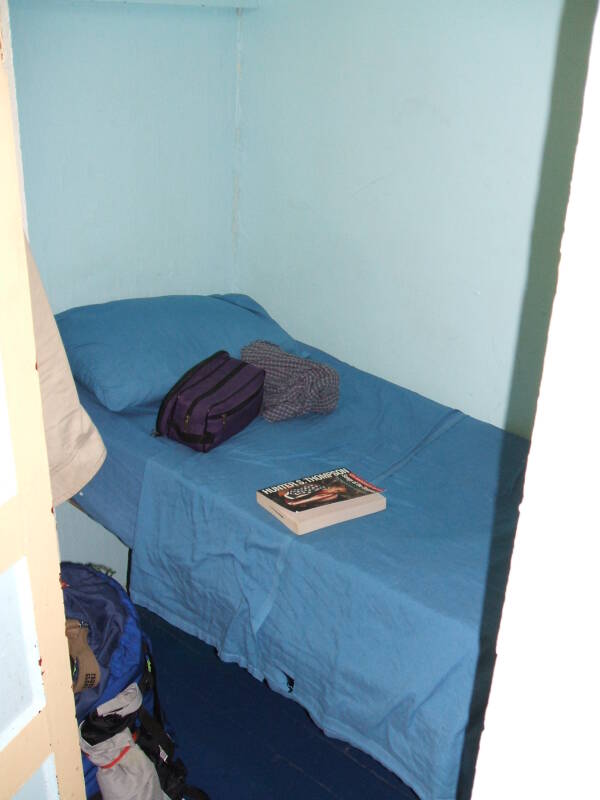

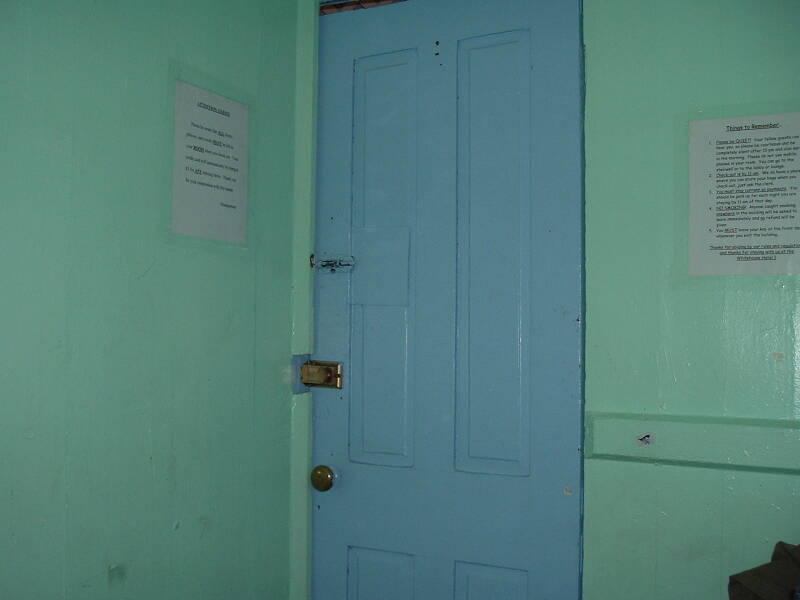
Each room has a deadbolt lock, you could hang the key ring on its knob. No electrical outlets, just a short fluorescent tube if you wanted light.
Some floors were painted with light green walls, others with white. Blue doors everywhere as if you were in the Greek islands.
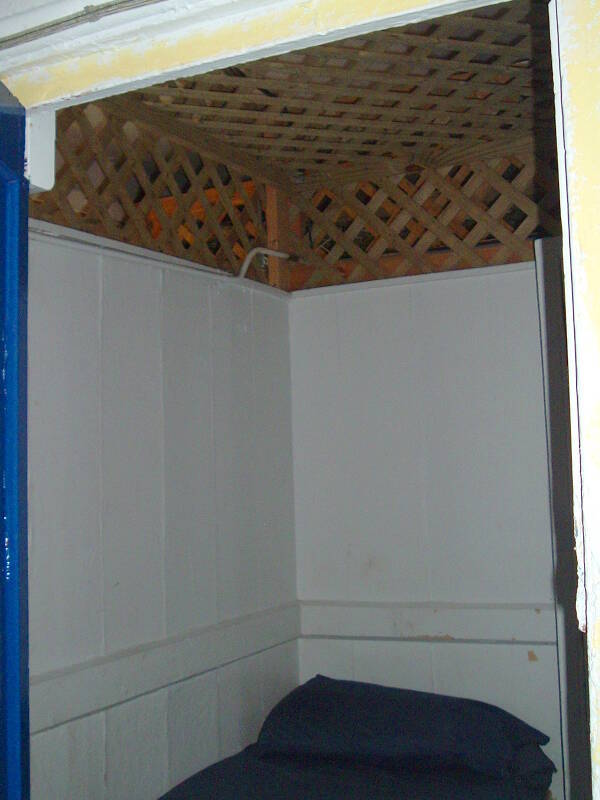
The Plumbing
This was all shared, the same as it was in all but the more luxurious hotels at least through the first third of the 20th century. Some sinks and toilet stalls appear in the first picture, and a door into a shower in the second picture below.
The hostel side was mixed, male and female, with shared toilets and showers. The permanent resident side was all men.
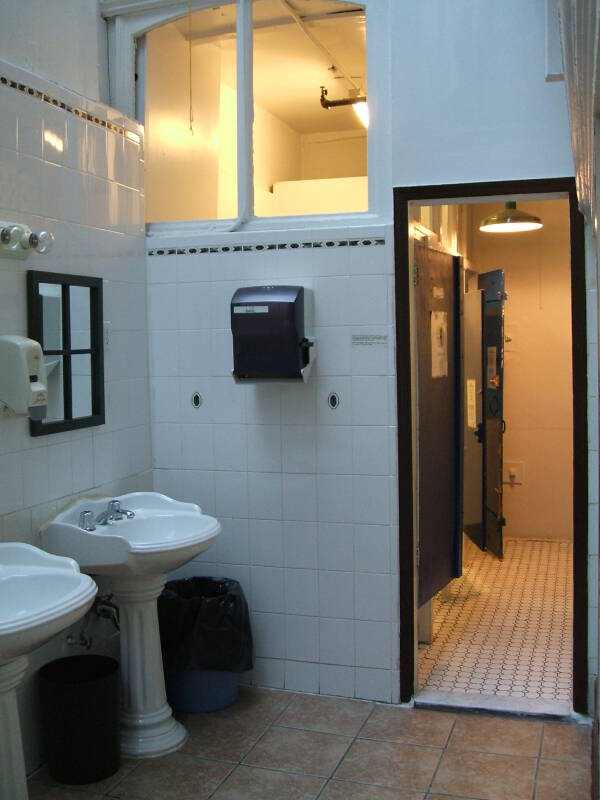
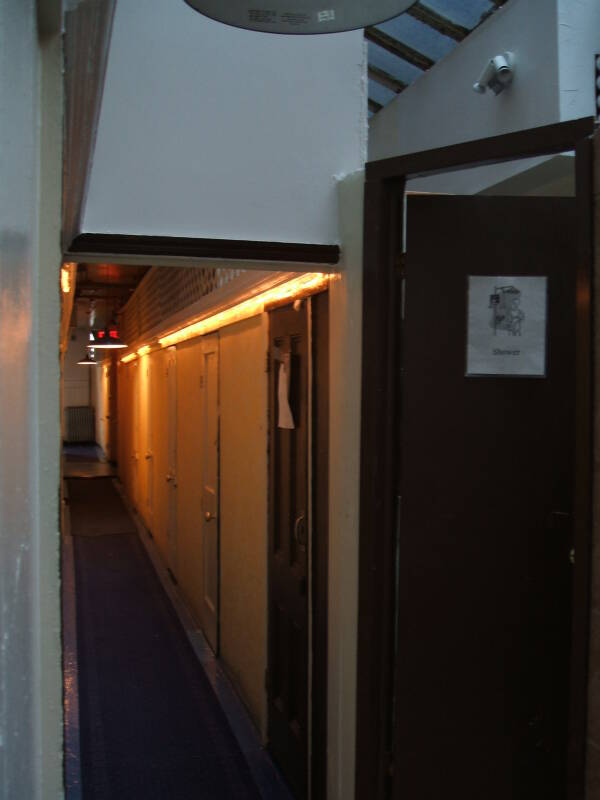
There were actual marble panels dividing some of the toilet stalls. One or two floors had some original urinals, put in when urinals were enormous floor-mounted units.
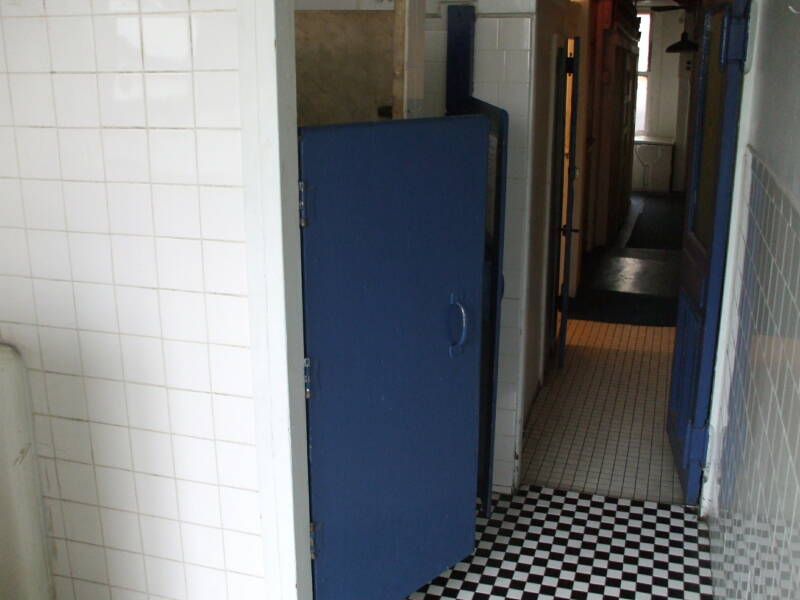
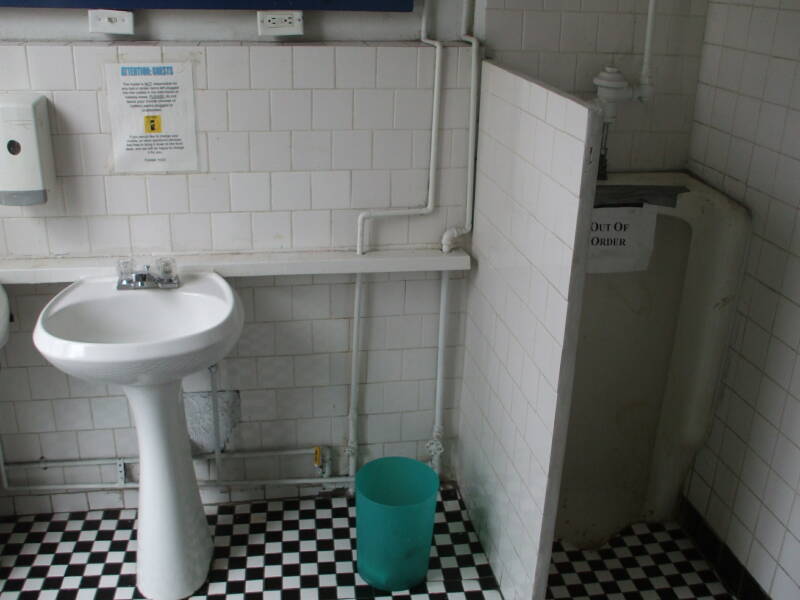
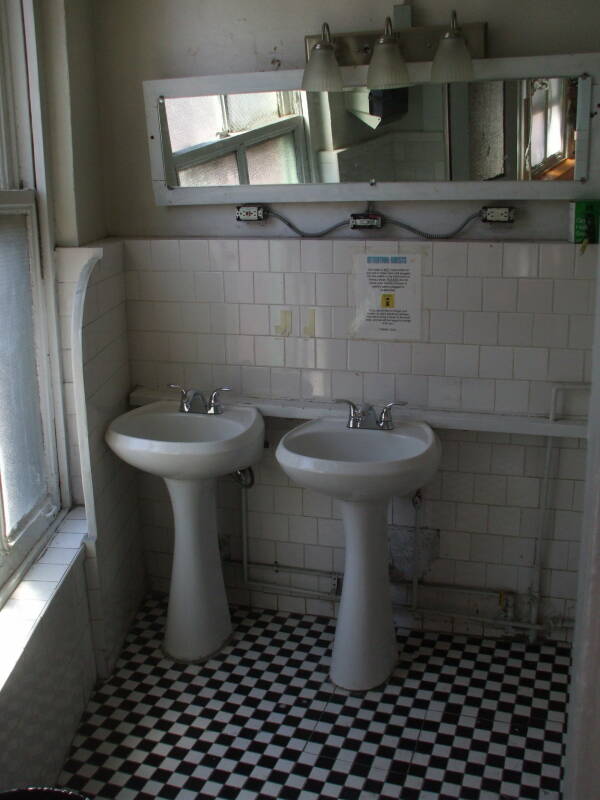
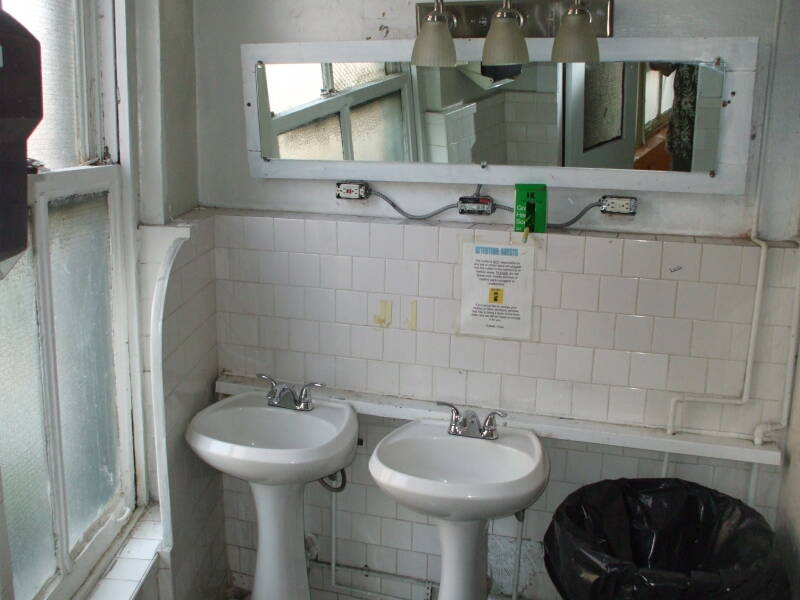
The partial remains of an electric motor dating back to the early 1900s have been embedded in untold coats of white paint. This would once have powered a ventilation fan mounted in this street-side window.
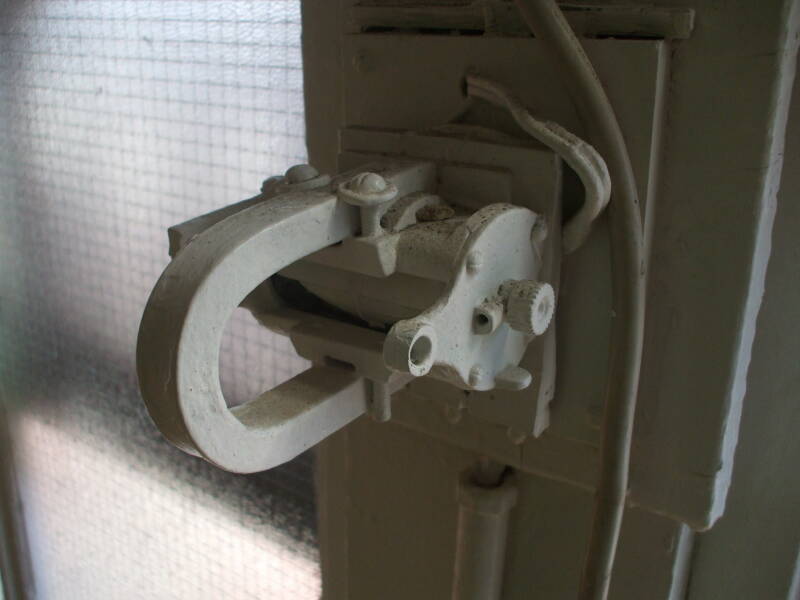
The Neighborhood
TheMudd Club
CBGB & OMFUG was a music club on Bowery facing the end of Bleecker Street, just a block and a half down Bowery from the White House. The club opened in 1973, hosting bands playing a variety of music. The name stands for Country, Bluegrass, and Blues and Other Music For Uplifting Gourmandizers. The Ramones, Patti Smith, Blondie, the Talking Heads, and other acts are associated with it. The Police played their first U.S. shows here, and the B-52's, Joan Jett, and other big names played here.
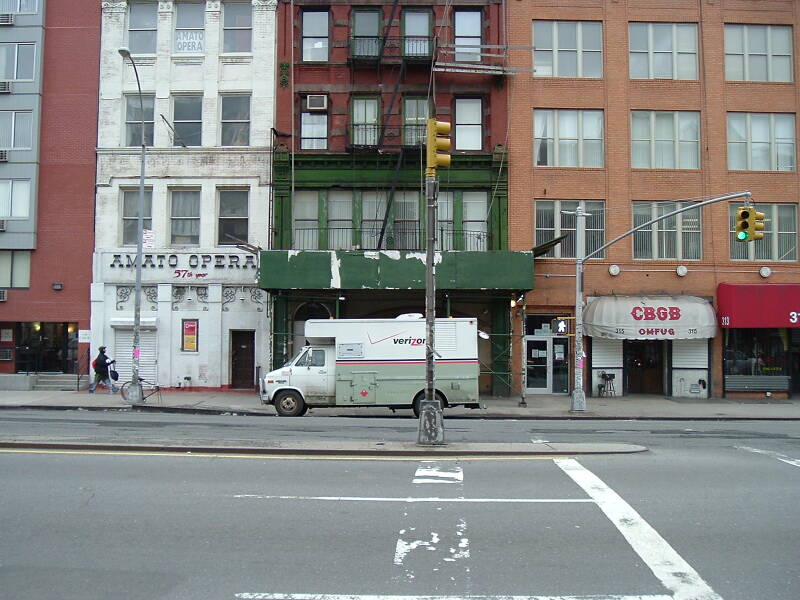
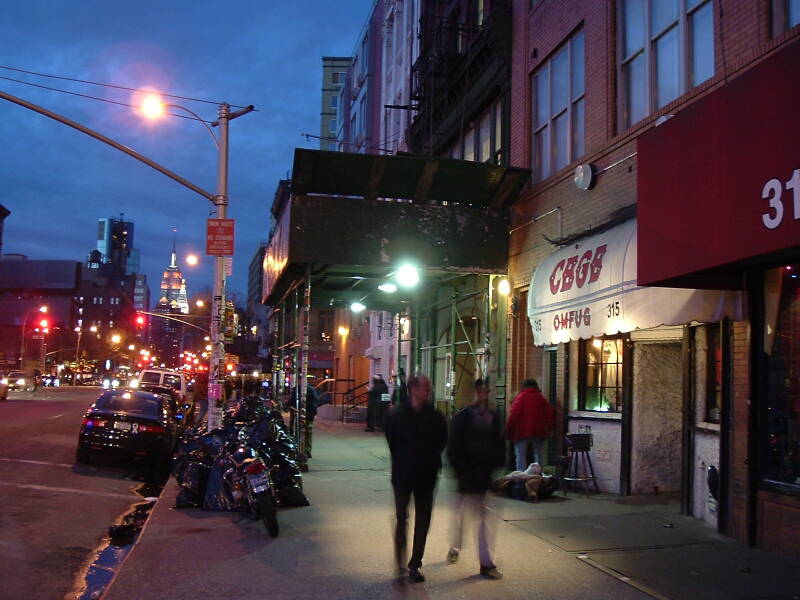
The last show was on October 15, 2006, after a legal battle over rent.
The short-lived Morrison Hotel art gallery was next door briefly. Now fashion designer John Varvatos has a store in the CBGB location, and a Patagonia clothing store is next door.
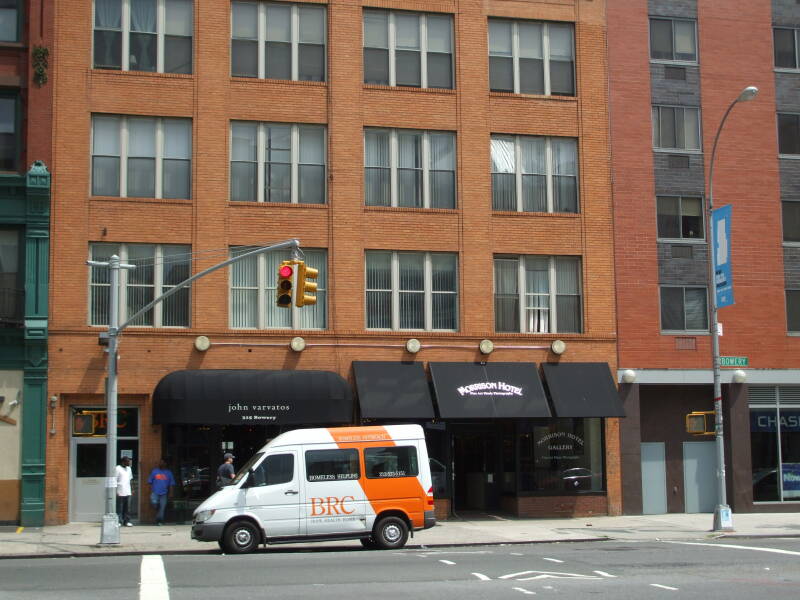
By November 2016 there was a mural of Joey Ramone at the east end of Bleecker where it tees into Bowery, across from the former site of CBGB.
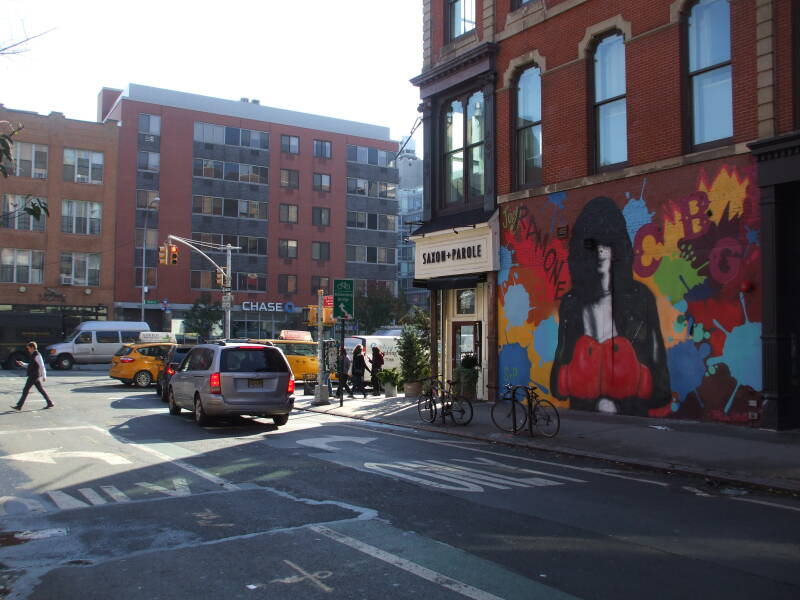
By March 2022 it had been replaced with a Blondie mural.
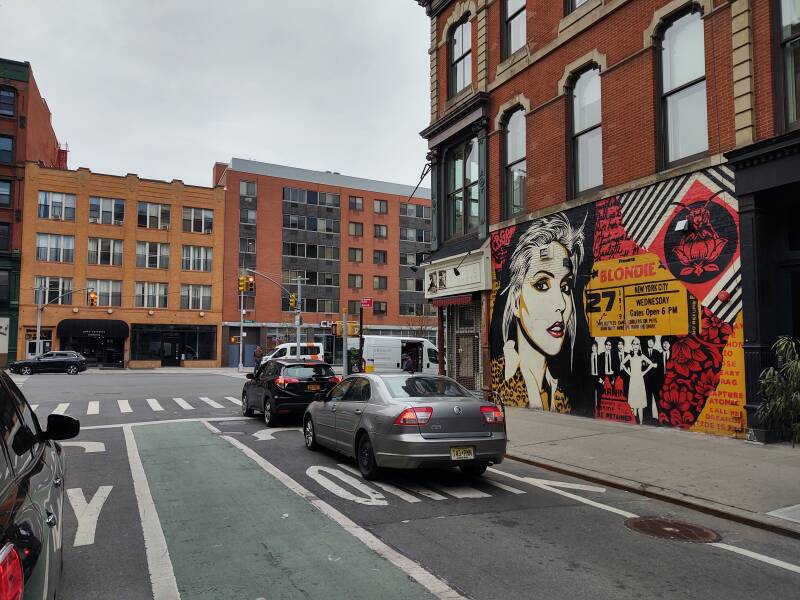
In the first picture below, we're looking out through the White House's fire escape in April of 2006. The Salvation Army mission is still there on the northeast corner of Bowery and 3rd Street. A demolition–construction project is underway across Bowery.

By November 2012, the Bowery Hotel and its Gemma restaurant had opened directly across Bowery from the White House.
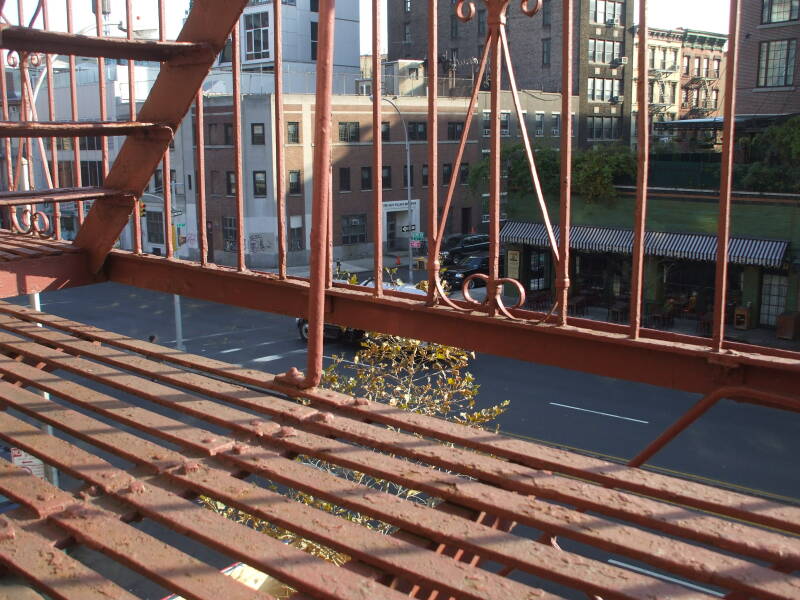
Rooms at the Bowery Hotel are listed at $345 per night and up, so over ten times the per-cabin nightly rate on the hostel side of the White House, and more than 41 times the residential rate. The restaurant's menu includes antipasti from $8–15, insalati from $9–13, pasta from $15–21, secondi from $22–29, and cocktails starting at $11.
In the summer of 2015 the Salvation Army mission had been demolished and a 13-story building with condos above ground-floor retail was under construction.
3rd StreetMen's Mission
The 3rd Street Men's Mission was still operating just behind the Bowery Hotel on 3rd Street. In 1991 Project Renewal converted the location from a place where up to 2,000 men were once actively using and selling drugs into a program housing 200 otherwise homeless men.
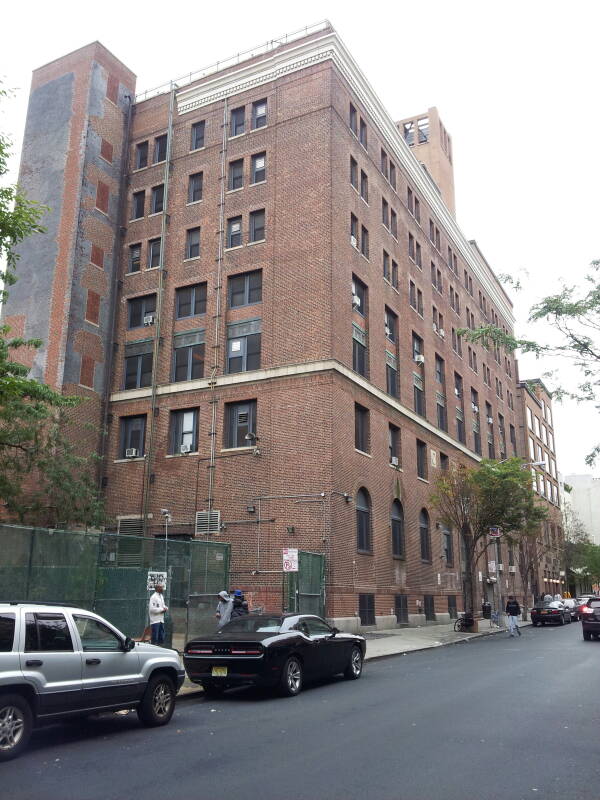
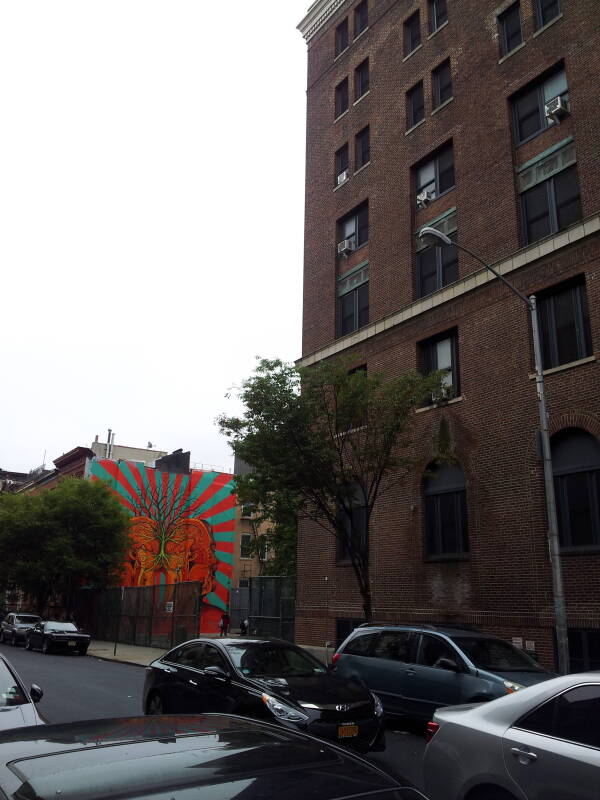
and reopening
Next: The White House was struggling to stay in operation as both an SRO on the permanent resident side and a hostel on the itinerant side. There was a temporary shutdown over fire codes, a lengthy and expensive renovation, and a reopening. But in the end, the White House shut down for good when there were still a handful of permanent residents living there.
USA Travel Destinations
Back to International Travel